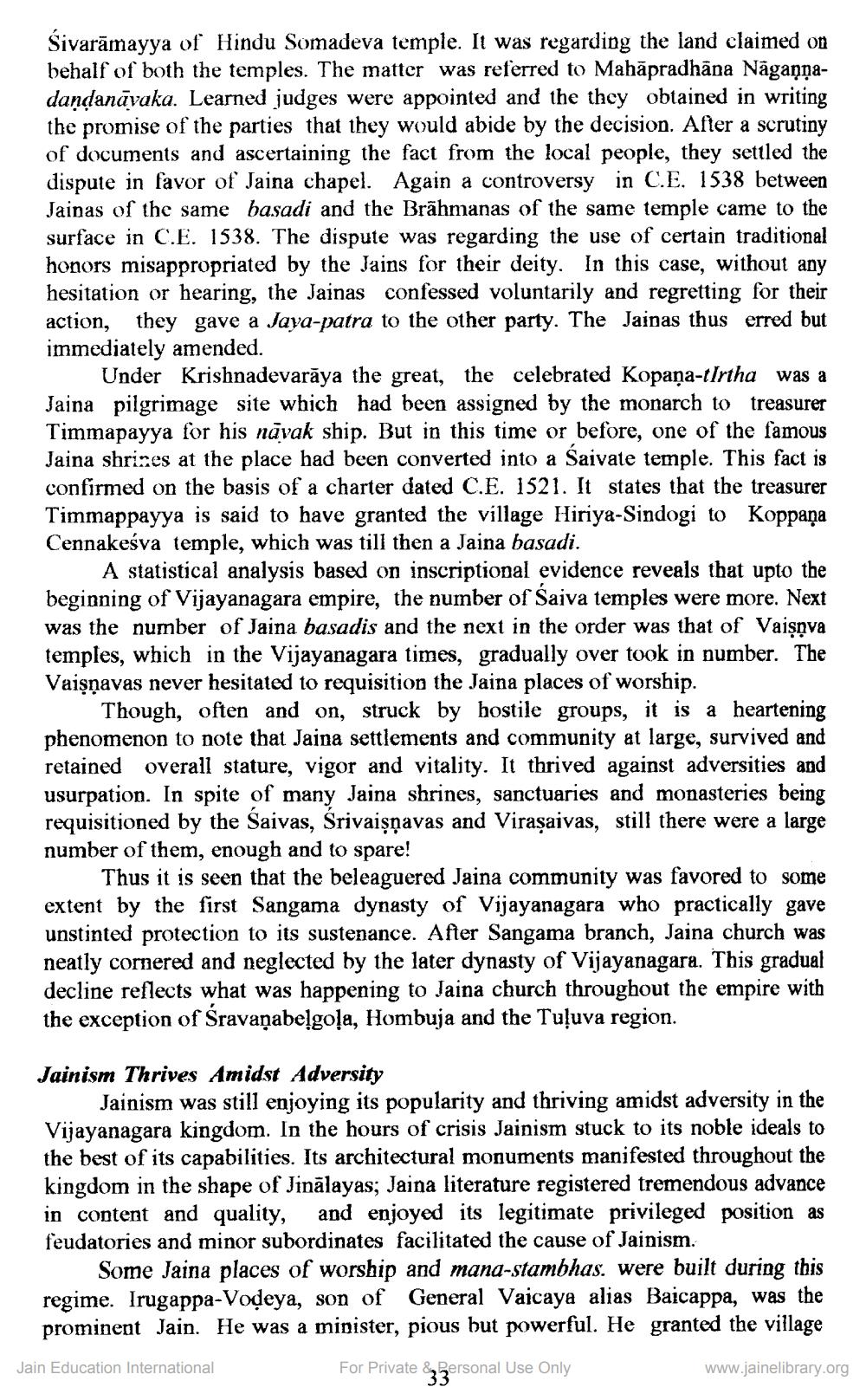________________
Sivarāmayya of Hindu Somadeva temple. It was regarding the land claimed on behalf of both the temples. The matter was referred to Mahāpradhāna Nāgaņņadandanavaka. Learned judges were appointed and the they obtained in writing the promise of the parties that they would abide by the decision. After a scrutiny of documents and ascertaining the fact from the local people, they settled the dispute in favor of Jaina chapel. Again a controversy in C.E. 1538 between Jainas of the same basadi and the Brāhmanas of the same temple came to the surface in C.E. 1538. The dispute was regarding the use of certain traditional honors misappropriated by the Jains for their deity. In this case, without any hesitation or hearing, the Jainas confessed voluntarily and regretting for their action, they gave a Jaya-patra to the other party. The Jainas thus erred but immediately amended.
Under Krishnadevarāya the great, the celebrated Kopaņa-tirtha was a Jaina pilgrimage site which had been assigned by the monarch to treasurer Timmapayya for his navak ship. But in this time or before, one of the famous Jaina shrines at the place had been converted into a Saivate temple. This fact is confirmed on the basis of a charter dated C.E. 1521. It states that the treasurer Timmappayya is said to have granted the village Hiriya-Sindogi to Koppaņa Cennakeśva temple, which was till then a Jaina basadi.
A statistical analysis based on inscriptional evidence reveals that upto the beginning of Vijayanagara empire, the number of Saiva temples were more. Next was the number of Jaina basadis and the next in the order was that of Vaişņva temples, which in the Vijayanagara times, gradually over took in number. The Vaişņavas never hesitated to requisition the Jaina places of worship
Though, often and on, struck by hostile groups, it is a heartening phenomenon to note that Jaina settlements and community at large, survived and retained overall stature, vigor and vitality. It thrived against adversities and usurpation. In spite of many Jaina shrines, sanctuaries and monasteries being requisitioned by the Saivas, Srivaiṣṇavas and Viraşaivas, still there were a large number of them, enough and to spare!
Thus it is seen that the beleaguered Jaina community was favored to some extent by the first Sangama dynasty of Vijayanagara who practically gave unstinted protection to its sustenance. After Sangama branch, Jaina church was neatly cornered and neglected by the later dynasty of Vijayanagara. This gradual decline reflects what was happening to Jaina church throughout the empire with the exception of Sravaņabe!goļa, Hombuja and the Tuļuva region.
Jainism Thrives Amidst Adversity
Jainism was still enjoying its popularity and thriving amidst adversity in the Vijayanagara kingdom. In the hours of crisis Jainism stuck to its noble ideals to the best of its capabilities. Its architectural monuments manifested throughout the kingdom in the shape of Jinālayas; Jaina literature registered tremendous advance in content and quality, and enjoyed its legitimate privileged position as feudatories and minor subordinates facilitated the cause of Jainism.
Some Jaina places of worship and mana-stambhas. were built during this regime. Irugappa-Vodeya, son of General Vaicaya alias Baicappa, was the
prominent Jain. He was a minister, pious but powerful. He granted the village Jain Education International For Private Bersonal Use Only
www.jainelibrary.org




